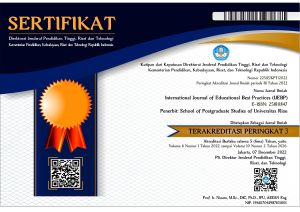The Autonomous Learners’ Language Learning Strategies at Senior High Schools in Coastal Areas of Riau Province - Indonesia
DOI:
https://doi.org/10.31258/ijebp.1.2.72-86Keywords:
Language learning strategies, autonomous learnersAbstract
This study focuses on examining the use of Language Learning Strategies (LLS) by autonomous learners at senior high schools in relation to the type of school and academic factors in Dumai, Bengkalis, and Selat Panjang (coastal areas). The study also concentrates on the preferred by ways operated by the selected respondents to master general English, four language skills, vocabulary, and structure. The target groups of the research are autonomous learners ( more or less 3000 students) from state senior high schools in three different small towns. Due to the homogenous characters of the target groups; academic achievement, age, and learning motivation, the sample is taken randomly as big as 10% out of the population. To collect the needed data quantitatively, the strategy inventory for language learning (SILL) (Oxford 1990) is applied, and for the qualitative data, an interview is conducted to 60 selected learners out of the sample. To analyze the quantitative data, descriptive and inferential statistics are used and for the qualitative data, listing the preferred ways are made accordingly. The findings reveal that the various LLS are used based on academic and types of school backgrounds. The social strategy is the highest use of LLS (402) among other strategies (memory, cognition, compensation, metacognition, and affection). The qualitative findings exist in the body of this article (table 6 – through table 8). The suggestion is that LLS would be better to be well instructed and discussed in the classroom.
References
Chamot & O‘Malley. (1987). The cognitive academic language learning approach: a bridge to the mainstream. TESOL Quarterly 21:227-249. Cohen, A.D. (1996). Verbal reports as a source of insights into second language
learner strategies. Applied Language learning, 7 (1&2): 5-24.
Ellis, R. (1994). The study of second language acquisition. Oxford: Oxford University Press.
Fakhri Ras. (2012). The use of language learning strategies by Pekanbaru Senior High School students and their socio-economic, academic, and type of school. Bangi: Universiti Kebangsaan Malaysia.
Fakhri Ras. (2016). The use of language learning strategies by Pekanbaru Senior High School students and their socio-economic, academic, and type of school.Bangi: Universiti Kebangsaan Malaysia.
Lan, Rae L. (2005). Language learning strategies profiles of EFL elementary school students in Taiwan. Maryland: Department of Curriculum and Instruction University of Maryland.
O‘Malley &Anna Uhl Chamot. (1990). Learning strategies in second language acquisition. Cambridge: Cambridge University Press.
Oxford, R & Nyikos, M. (1989). Variables affecting choice of language learning strategies by university students. Modern Language Journal, 73: 291-300.
Oxford, R & Crookall, D. (1990). Research on language learning strategies worldwide with ESL/EFL version of the strategy inventory for language learning (SILL). System, 25 (1):4-23.
Oxford, R.L. (1990)a. Use of language learning strategies: a synthesis of studies with implications for strategy training. System, 17: 235-247.
Rao Zhenhui. (2005). Gender, Academic Major, and Chinese Students‘ Use of Language Learning Strategies: Social and Educational Perspectives. The Journal of Asia Tefl Vol. 2(3), 115-138.
Rubin, J. (1987). Learners' strategies: theoretical assumptions, research history, and typology. In. A. Wenden & J. Rubin (Eds.). Learner strategies in language learning, 15-29.
Rubin, J. (1975). What the ―good learner‖ can teach us. TESOL Quarterly, 41-51.Stern, H. H. (1975). What can we learn from the good language learners?. Canadian Modern Language Review, 31 (3): 304-318.
Tarone, E. (1983). Some thoughts on the notion of „communication strategy” in C.Faerch & G.Kaspur (Eds.). Strategies in interlanguage communication. New York: Longman.





